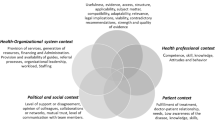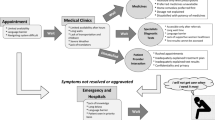Abstract
Background Use of antibiotics has been correlated with increasing rates of resistance. Pharmacists are ideally positioned as front line health care providers to limit indiscriminate antibiotic use and promote the safe and effective administration of these medications. Objective The aim of this project was to assess pharmacists’ opinions relating to antibiotic utilization in the community setting. Setting Doha, Qatar. Method Community and primary care pharmacists were invited to participate in one of three focus groups or a semi-structured interview at Qatar University or at their site of employment. A total of 22 community and primary care pharmacists participated in this study. Interviews were facilitated using a focus group guide, were recorded, and later transcribed. Transcripts were reviewed for recurring themes and coded using Nvivo software for qualitative research. Main outcome measure Pharmacists’ perceptions. Results Five major themes emerged from a series of focus groups and interviews. Themes which recurred across interview groups included: misconceptions and inappropriate practices by patients and healthcare providers, currently implemented strategies, perceived barriers, ways to overcome perceived barriers, and targets for improvement of antibiotic use in Qatar. The greatest need, as identified by pharmacists in this study was increased knowledge of the general population about appropriate antibiotic use through various educational interventions. Conclusion Pharmacists report a number of misconceptions and inappropriate practices relating to antibiotic use in Qatar by patients and healthcare providers. Education to improve knowledge of appropriate antibiotic use is needed. Despite recognition of these issues, barriers are preventing pharmacists from implementing strategies to improve antibiotic use in Qatar.
Similar content being viewed by others
References
Collignon P, Goldmann D, Goosens H, Gyssens IC, Harbarth S, Jarlier V, et al. Society’s failure to protect a precious resource: antibiotics. Lancet. 2011;378:369–71.
Baquero F, Beltren JM, Loza E. A review of antibiotic resistance patterns of Streptococcus pneumoniae in Europe. J Antimicrob Chemother. 1991;28:31–8.
Gould IM. The epidemiology of antibiotic resistance. Int J Antimicrob Agents. 2008;32:S2–9.
Baquero F. Pneumococcal resistance to beta-lactam antibiotics: a global geographic overview. Microbial Drug Resist. 1995;1(2):115–20.
Song J-H, Jung S-I, Ko KS, Kim NY, Son JS, Chang H–H, et al. High prevalence of antimicrobial resistance among clinical Streptococcus pneumoniae isolates in Asia (an ANSORP Study). Antimicrob Agents Chemother. 2004;48(6):2101–7.
Umgelter A, Reindl W, Miedaner M, Schmid RM, Huber W. Failure of current antibiotic first-line regimens and mortality in hospitalized patients with spontaneous bacterial peritonitis. Infection. 2009;37(1):2–8.
Antibiotic/Antimicrobial resistance [Internet]. Atlanta, Georgia: Centers for Disease Control and Prevention. 2010 [updated 19 Sept 2012; cited 21 July 2013]. http://www.cdc.gov/drugresistance/index.html#.
Mackenbach JP, Looman CW. Secular trends of infectious disease mortality in The Netherlands, 1911–1978: quantitative estimates of changes coinciding with the introduction of antibiotics. Int J Epidemiol. 1988;17(3):618–24.
Norrby SR, Nord CE, Finch R, European Society of Clinical Microbiology and Infectious Diseases (ESCMID). Lack of development of new antimicrobial drugs: a potential serious threat to public health. Lancet Infect Dis. 2005;5(2):115–9.
Antimicrobial resistance [Internet]. World Health Organization. 2013 [updated May 2013; cited 21 July 2013]. http://www.who.int/mediacentre/factsheets/fs194/en/.
Costelloe C, Metcalfe C, Lovering A, Mant D, Hay AD. Effect of antibiotic prescribing in primary care on antimicrobial resistance in individual patients: systematic review and meta-analysis. BMJ. 2010;340. doi:10.1136/bmj.c2096.
Danish Integrated Antimicrobial Resistance Monitoring and Research Programme. Data for action: the Danish approach to surveillance of the use of antimicrobial agents and the occurrence of antimicrobial resistance in bacteria from food animals, food and humans in Denmark. 2nd ed. Denmark: National Food Institute; 2012.
Bell BG, Schellivis F, Stobberingh E, Goosens H, Pringle M. A systematic review and meta-analysis of the effects of antibiotic consumption on antibiotic resistance. BMC Infect Dis. 2014;14:13.
Seppala H, Klaukka T, Vuopio-Varkila J, Muotiala A, Helenius H, Lager K. The effect of changes in the consumption of macrolide antibiotics on erythromycin resistance in group A streptocococcus in Finland. N Engl J Med. 1997;337(7):441–6.
Hicks LA, Chien Y-W, Taylor TH Jr, Haber M, Klugman KP. Outpatient antibiotic prescribing and nonsusceptible streptococcus pneumonia in the United States, 1996–2003. Clin Infect Dis. 2011;53(7):631–9.
Al-Niemat SI, Bloukh DT, Al-Harasis MD, Al-Fanek AF, Salah RK. Drug use evaluation of antibiotics prescribed in a Jordanian hospital outpatient and emergency clinics using WHO prescribing indicators. Saudi Med J. 2008;29(5):743–8.
Kotwani A, Holloway K. Trends in antibiotic use among outpatients in New Delhi, India. BMC Infect Dis. 2011;11:99.
Gale NK, Heath G, Cameron E, Rashid S, Redwood S. Using framework method for the analysis of qualitative data in multi-disciplinary health research. BMC Med Res Methodol. 2013;13:117.
Patton MQ. Qualitative research and evaluation methods. 3rd ed. USA: Sage Publications; 2002.
Chan YH, Fan MM, Fok CM, Lok Z, Ni M, Sin CF, et al. Antibiotic nonadherence and knowledge in the community with the world’s leading prevalence of antibiotic resistance: implications for public health interventions. Am J Infect Control. 2012;40(2):113–7.
Lim KK, Teh CC. A cross sectional study of public knowledge and attitudes towards antibiotics in Putrajaya, Malaysia. South Med Rev. 2012;5(2):26–33.
Shahadeh M, Suaifan G, Darwish RM, Wazaify M, Zaru L, Alja’fari S. Knowledge, attitudes and behavior regarding antibiotics use in and misuse among adults in the community of Jordan: a pilot study. Saudi Pharm J. 2012;20(2):125–33.
Kadras P, Devine S, Golembesky A, et al. A systematic review and meta-analysis of misuse of antibiotic therapies in the community. Int J Antimicrob Agents. 2006;26:106–13.
Corbett KK, Gonzales R, Leeman-Castillo BA, Flores E, Maselli J, Kafadar K. Appropriate antibiotic use: variation in knowledge and awareness by Hispanic ethnicity and language. Prev Med. 2005;40(2):162–9.
Kotwani A, Wattal C, Joshi PC, Holloway K. Irrational use of antibiotics and role of the pharmacist: insight from a qualitative study in New Delhi, India. J Clin Pharm Ther. 2012;37:308–12.
World Health Organization consultative group. The role of the pharmacist in the healthcare system. World Health Organization. 1994. http://apps.who.int/medicinedocs/en/d/Jh2995e/1.6.2.html. Accessed 30 Sept 2013.
El-Hajj MS, Salem S, Mansoor H. Public’s attitude towards community pharmacy in Qatar: a pilot study. Patient Prefer Adherence. 2011;5:405–22.
Eades CE, Ferguson JS, O’Carroll RE. Public health in community pharmacy: a systematic review of pharmacist and consumer views. BMC Public Health. 2011;11:582.
Roque F, Soares S, Breitenfeld L, Lopez-Duran A, Figueiras A, Herdeiro MT. Attitudes of community pharmacists to antibiotic dispensing and microbial resistance: a qualitative study in Portugal. Int J Clin Pharm. 2013;35:417–24.
Coleman CL. Examining influences of pharmacists’ communication with consumers about antibiotics. Health Commun. 2003;15(1):79–99.
Saramunee, Krska J, Mackridge A, Richards J, Suttajit S, Phillips-Howard P. How to enhance public health service utilization in community pharmacy? General public and health providers’ perspective. Res Social Adm Pharm. 2014;10(2):272–284.
Supreme Council of Health. Medical Licensing. Supreme Council of Health. 2014. http://www.sch.gov.qa/sch/En/scontent.jsp?smenuId=19&CSRT=2308534528298525445. Accessed 1 March 2014.
Acknowledgments
The authors of this manuscript would like to thank the Qatar Petroleum Health and Wellness Center pharmacy department for their contributions to this project.
Funding
This study was completed with funding from an Internal Student Grant from Qatar University.
Conflicts of interest
The authors of this paper report no conflicts of interest.
Author information
Authors and Affiliations
Corresponding author
Rights and permissions
About this article
Cite this article
Black, E., Cartwright, A., Bakharaiba, S. et al. A qualitative study of pharmacists’ perceptions of, and recommendations for improvement of antibiotic use in Qatar. Int J Clin Pharm 36, 787–794 (2014). https://doi.org/10.1007/s11096-014-9960-7
Received:
Accepted:
Published:
Issue Date:
DOI: https://doi.org/10.1007/s11096-014-9960-7




